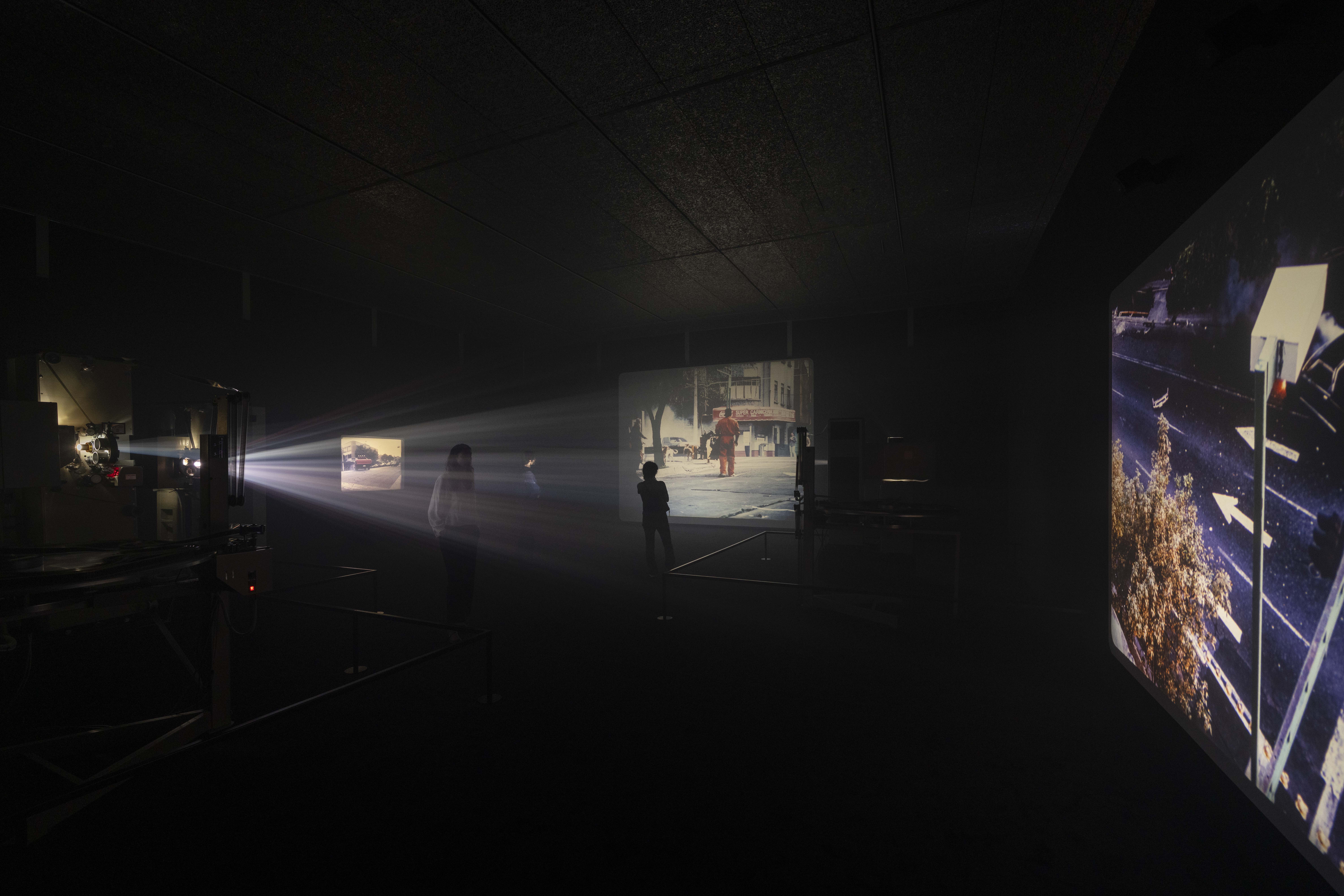A tablecloth and a protective plastic roll are commonly found in kitchens, corner shops, and deli counters. When these everyday materials appear cut, layered, and reassembled into fragile, fresco-like compositions, inside a white-cube gallery in central London, the effect is both surprising and intriguing. What might once have seemed tacky or unpleasant to touch is transformed into something delicate and desirable. This constant shift between interior and exterior, utility and ornament, becomes a central thread in In Lawless Romantic Underworld, where artist Loveday Pride explores how everyday objects can shift in meaning: from functional to decorative, domestic to public, overlooked to staged.

Acrylic, paper, protector roll on banquet cloth
183 x 340 cm
This approach stems from designing a float for the Pewsey Carnival at the end of 2024. Working closely with the community, exploring the history of the carnival, and transforming mundane objects into new, reimagined forms proved vital — not only as a material practice but as a catalyst for new ways of thinking. Carnival itself is a continual process of transformation. In Rabelais and His World (1965), philosopher and literary critic Mikhail Bakhtin describes carnival as an inversion of binary oppositions. It serves as an alternative to official celebrations, offering a fleeting liberation from the prevailing order by temporarily abolishing hierarchical relationships, privileges, and norms. Its logic turns everything inside out, reversing top and bottom, and challenging social structures. For Pride, the carnivalesque inversion extended beyond lived experience to become an artistic method.

acrylic and metallic marker on dust sheet, acrylic on banquet cloth
The materials Loveday Pride uses and their origins are constantly reinterpreted. As a cheap, store-bought item transforms first into carnival material and then into a folded collage displayed vertically in the gallery, rather than laid flat as a domestic object. The dust cover, once intended solely to protect the “real” artwork and quietly collect dust, shifts from a background object to the focus of attention. Its plastic surface glows with warm honey tones that seduce viewers, offering a glimpse of what lies beneath while simultaneously disrupting their focus. Random illusory silhouettes appear on the plastic cover alongside precise gold metallic marker drawings that mimic the gallery’s architecture, especially the ornate railings outside the building. These forms were created using a tablecloth as a stencil, mapping squares filled with smaller, intricate line patterns. What might have been purely functional drawing becomes ornament, blurring the boundary between utility and decoration.

Acrylic on canvas
76 x 102 cm
The intervention lies in both material and meaning. The Existential Comic references the Wiltshire folk tale of the Moonrakers — smugglers who hid barrels of illegal alcohol in a pond and fooled revenue officers by claiming they were “raking a round cheese” from the water, an illusion created by moonlight reflecting off the barrels. Loveday Pride sees the fools as wise, using appearance and misdirection as tools for survival. In that moment, the moon becomes cheese, light becomes substance, and reflection becomes reality. In this work, a smiling moon hovers between joy and anxiety, lightness and breakdown. It serves as a portrait of the present moment, where laugh and horror are no longer opposites and catastrophe can become a meme. This theme, which also glimmers through her small, slightly psychedelic paintings, suggests that illusion is not deception but a playful, temporary departure from reality - one that invites us to rethink the order of things.

acrylic, watercolour and pencil on calico on panel
There is something undeniably carnivalesque about the current state of the world. It is chaos where the fool becomes king, where good and bad constantly trade places, and meaning feels disturbingly relative. Hierarchies fracture but often reassemble in new forms, especially within art spaces once meant to dismantle them. Still, something new may be emerging — one that does not follow vertical or horizontal logic but suggests an entirely different kind of paradigm. This is where the curatorial work of Alexander Bokser and Henry Pride at Pusher adds another layer. Located in Holborn, the gallery unsettles London’s spatial hierarchies, where neighborhoods are often defined by the kind of art they are expected to show. Seeing Loveday Pride’s work in a wealthy area, where she playfully juggles what counts as “high” and “low” materials, rearranging and repurposing them, echoes a carnival experience itself.
—
Loveday Pride (b. 2001, Salisbury, UK) lives and works in London, UK. Loveday is an artist making paintings and expanded painterly objects which combine lo-fi materials and brightly coloured abstract languages, whilst questioning the intersection between art making and everyday culture. Beginning with objects ready at hand, she then finds small moments in time or materiality to fixate on and build work out from, realising an intentionality in the ‘off-cut’. Loveday completed her BFA at Ruskin School of Art, Oxford, (2023). She is currently undertaking her MFA at The Slade, London. Selected Exhibitions include: Our Thin Heir, The Mills Centre Gallery, London (2025), Bog, Bermondsey Arts Club, London (2024), 35.5714286, SPLIT, London (2024), Rivers Livers, They Come. They Sit. They Go., London (2024), Rehearsals, Filet, London (2024), A Room of One’s Own, Irving Gallery, Oxford (2024), Nights at the Circus, Pusher at Greatorex Street, London (2023), Among the Garbage and the Flowers, Le 6B, Paris (2021). Awards include: Winner of the Gibbs Proxime Prize awarded by Ruskin School of Art (2023), Nominee for Freelands Painting Prize (2023), Nominee for the Kevin Slingsby Prize, Oxford (2022).
Sofia Anna Dolin is a cultural historian and writer based in London.




